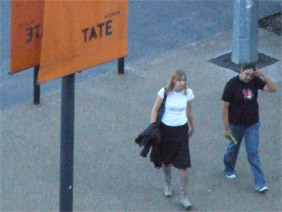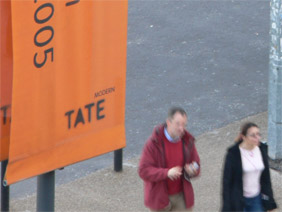Fujifilm FinePix S9500 Zoom / FinePix S9000 Zoom review
-
-
Written by Gordon Laing
Finepix S9500 / S9000 zoom lens
The Fujifilm Finepix S9500 is equipped with a long 10.7x optical zoom with a 35mm-equivalent range of 28-300mm and a focal ratio of f2.8~4.9; the actual focal length is 6.2-66.7mm. Like most high-end all-in-ones these days, the zoom is operated by a tactile mechanically-linked ring; this extends the barrel by 33mm when fully zoomed-in – see below. A lens hood is supplied, and the front lens element doesn’t rotate during focussing, allowing the easy use of polarising filters.
A dial on the side of the camera switches between continuous, single and manual focussing modes, with a separate macro button below it which selects between normal and Super Macro mode. Like most all-in-ones, the S9500 employs an electrically assisted manual focussing ring, although again like most all-in-ones, it’s not a patch on manually focussing with a genuine optical SLR.
The Super Macro mode can focus as close as 1cm, which while impressive, is virtually impossible to exploit without casting shadows on your subject. That said, even if you retreat to around two or three cm, you can still enjoy excellent close-up capabilities – see our Results and Gallery pages.
The S9500’s long optical zoom range is very useful, particularly the 28mm wide angle end when most manufacturers settle for starting at 35mm. This gives you the flexibility of capturing decent wide views, while also being able to zoom-in on distant detail. Sony’s R1 gets a little wider still at 24mm, but only zooms into 120mm. Panasonic’s FZ30 starts at a relatively modest 35mm, but extends to a whopping 420mm; it’s all a case of weighing up which range suits you best. One thing’s for certain though: all are far more flexible than the typical 3X optical range you get with budget digital SLR kit lenses.
To illustrate the S9500’s coverage, we took the same photo from the same position on a tripod using it and Panasonic’s DMC-FZ30 which offers a 12x optical range equivalent to 35-420mm. The photos below were taken moments apart.
Zoomed-out to wide-angle, the S9500 captures a visibly wider field than the 35mm equivalent focal length of the Panasonic DMC-FZ30, although not as wide as the 24mm equivalent of Sony’s Cyber-shot DSC-R1.
Below are examples of both cameras zoomed all the way in, again taken from exactly the same position and moments apart. Here the massive 300 and 420mm equivalent focal lengths of each camera demonstrate their impressive reach over both the Sony R1’s 120mm equivalent, and the relatively paltry capabilities of a typical 3x lens bundled with a digital SLR. Note, there are similar lens coverage examples taken with the Sony R1 and Canon 350D / Digital Rebel XT from exactly the same spot, although on a different day in our Sony R1 review here.
The Panasonic unsurprisingly wins in this respect, although whether it’s offers a greater benefit than the wider angle of the Fujifilm S9500 is entirely down to personal preference and your style of photography.
Fujifilm FinePix S9500 Zoom |
Panasonic DMC-FZ30 | |
 |  | |
| 6.2-66.7mm at 66.7mm, f8 (300mm equivalent) | 7.4-88.8mm at 88.8mm, f8 (420mm equivalent) |
Long focal lengths are all very well, but they increase the risk of camera shake. While many manufacturers counter this with optical image stabilisation, Fujifilm has opted for a simpler electronic solution: simply increase the ISO to allow faster shutter speeds. So where most all-in-ones peak between 400 and 640 ISO, the S9500 offers sensitivity from 80 right up to 1600 ISO. This will certainly let you achieve the kind of shutter speeds required to avoid camera shake under most conditions.
Of course by increasing sensitivity, you also suffer from higher noise levels. See our results pages to compare the S9500 with the Panasonic FZ30, along with the Sony R1 and Canon EOS-350D which both feature physically larger sensors. While optical stabilisation may seem the technically preferable solution though, it must be said it won’t freeze any subject in motion. In contrast, while higher ISOs increase the noise levels, they do allow faster shutter speeds both freezing action and reducing the risk of camera shake.
To illustrate this we took handheld photos of the same subject with both the S9500 and the Panasonic FZ30 zoomed-in to their maximum focal lengths; the photos were taken within moments of each other. We’ve taken 1410×1060 pixel crops from each image to show similar areas, then reduced them by five times for 20% reproduction below. Each crop represents approximately 2/5 of the original image coverage. The FZ30 shows a smaller area because its focal length was longer and the resolution slightly lower. Despite slightly different resolutions, the reproduction of both crops from the original images is roughly equivalent and adequate to illustrate this example.
Fujifilm FinePix S9500 Zoom |
Panasonic DMC-FZ30 | |
 |  | |
|
6.2-66.7mm at 66.7mm, f8 (300mm equivalent) 1600 ISO, 1/350th |
7.4-88.8mm at 88.8mm, f8 (420mm equivalent) 80 ISO, 1/13th |
At 80 ISO, the S9500 required a shutter speed of 1/13th, which for a focal length equivalent to 300mm was far too slow to handhold without considerable camera shake. Fujifilm’s answer is of course to increase the sensitivity, and once we’d set the camera to 1600 ISO, the exposure had shortened to 1/350th, allowing a sharp handheld result.
Set to 80 ISO, the FZ30 also required a shutter speed of 1/13th, but amazingly its optical image stabilisation allowed us to handhold the shot without any camera shake – and this was at a longer equivalent focal length of 420mm.
As explained earlier though, both approaches have their pros and cons. The high sensitivity demanded by the S9500 may have resulted in high noise levels and also some smearing of detail, but any motion has been frozen. In contrast the stabilisation of the Panasonic may have allowed us to handhold at 80 ISO and enjoy a noise-free image, but the long zoom and slow shutter speed have resulted in blurring of motion. Which is better depends on your style of photography. If you shoot moving subjects, the S9500’s higher sensitivity has the edge. Conversely if you shoot mostly static subjects the FZ30 will be more suitable. Either way, you can’t help but be impressed by the stabilisation of the Panasonic FZ30.
Finepix S9500 / S9000 zoom sensor and files
The S9500 employs a 9 Megapixel SuperCCD HR sensor measuring 1/1.6in and delivering 4:3 aspect ratio images with a maximum of 3488×2616 pixels. Unlike many SuperCCD sensors in the past, the S9500’s does not employ any scaling – it really is a genuine 9 Megapixel sensor.
In total six different resolution modes are available including one with 3:2 aspect ratio images measuring 3696 x 2464 pixels. The largest 9 Megapixel images can be recorded with the choice of two JPEG compression levels or as RAW files; best quality JPEGs measure around 4.5MB each. Very basic RAW software is supplied, so for a more practical approach to processing you’ll really need third-party software; thankfully, Adobe Camera RAW version 3.3 now supports the S9500 / S9000.
The S9500 sports slots for both xD and Compact Flash (Type I and II) memory cards. The UK package tested included a modest 16MB xD card to get you started, although this may vary depending on your region and the supplier’s offer.
Video recording
With the command dial set to video, you have the choice of recording in either VGA 640×480 resolution or QVGA 320×240, both at 30fps with sound. In VGA mode, the video was smooth and detailed, and consumed just over 1MB per second.
Handling
The S9500 starts up and is ready for action in about one second, which makes it noticeably slower than the 0.2 second startup of the latest budget digital SLRs. That said during our test period we rarely found it limiting. Switching to Play mode takes just over two seconds to display the first image, and there’s about a one second delay to go from one to the next (using best quality JPEGs). Thumbnails in playback appear almost instantly.
There are three continuous shooting options, one recording the first four images in sequence, the second recording the last four images in a sequence, and the third recording as many images as you have space for on the card.
Using the supplied xD card and the best quality JPEG mode we found the first two modes could take their four images in around 2.5 seconds, giving a rate of 1.6fps. Switching to unlimited mode though reduced the speed to around 1fps, and strangely is only available in fully Auto mode.


6.2-66.7mm at 6.2mm, f8 (28mm equivalent)
7.4-88.8mm at 7.4mm, f8 (35mm equivalent)




